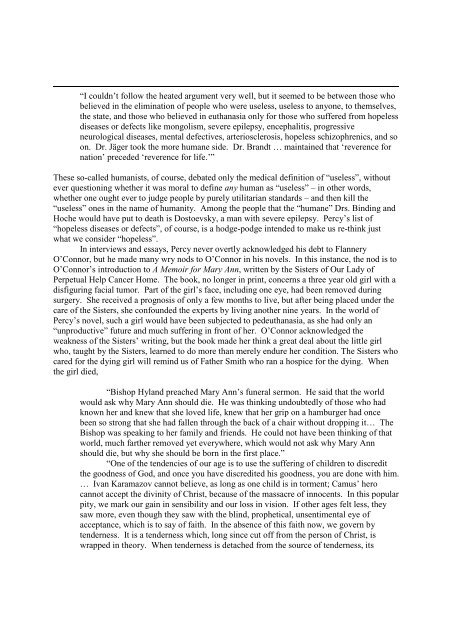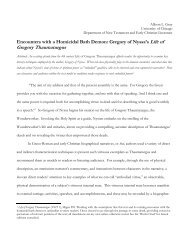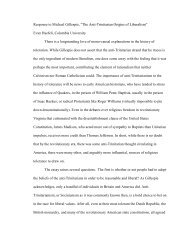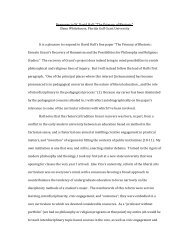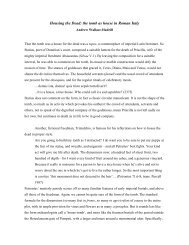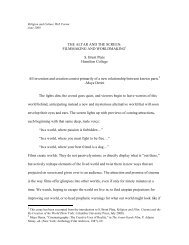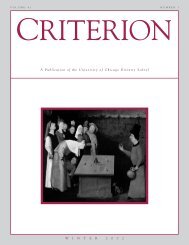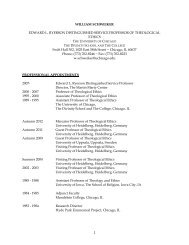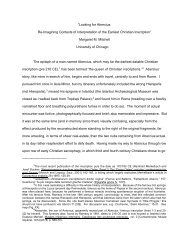The Reification of Evil and The Failure of Theodicy: The Devil in ...
The Reification of Evil and The Failure of Theodicy: The Devil in ...
The Reification of Evil and The Failure of Theodicy: The Devil in ...
Create successful ePaper yourself
Turn your PDF publications into a flip-book with our unique Google optimized e-Paper software.
“I couldn’t follow the heated argument very well, but it seemed to be between those who<br />
believed <strong>in</strong> the elim<strong>in</strong>ation <strong>of</strong> people who were useless, useless to anyone, to themselves,<br />
the state, <strong>and</strong> those who believed <strong>in</strong> euthanasia only for those who suffered from hopeless<br />
diseases or defects like mongolism, severe epilepsy, encephalitis, progressive<br />
neurological diseases, mental defectives, arteriosclerosis, hopeless schizophrenics, <strong>and</strong> so<br />
on. Dr. Jäger took the more humane side. Dr. Br<strong>and</strong>t … ma<strong>in</strong>ta<strong>in</strong>ed that ‘reverence for<br />
nation’ preceded ‘reverence for life.’”<br />
<strong>The</strong>se so-called humanists, <strong>of</strong> course, debated only the medical def<strong>in</strong>ition <strong>of</strong> “useless”, without<br />
ever question<strong>in</strong>g whether it was moral to def<strong>in</strong>e any human as “useless” – <strong>in</strong> other words,<br />
whether one ought ever to judge people by purely utilitarian st<strong>and</strong>ards – <strong>and</strong> then kill the<br />
“useless” ones <strong>in</strong> the name <strong>of</strong> humanity. Among the people that the “humane” Drs. B<strong>in</strong>d<strong>in</strong>g <strong>and</strong><br />
Hoche would have put to death is Dostoevsky, a man with severe epilepsy. Percy’s list <strong>of</strong><br />
“hopeless diseases or defects”, <strong>of</strong> course, is a hodge-podge <strong>in</strong>tended to make us re-th<strong>in</strong>k just<br />
what we consider “hopeless”.<br />
In <strong>in</strong>terviews <strong>and</strong> essays, Percy never overtly acknowledged his debt to Flannery<br />
O’Connor, but he made many wry nods to O’Connor <strong>in</strong> his novels. In this <strong>in</strong>stance, the nod is to<br />
O’Connor’s <strong>in</strong>troduction to A Memoir for Mary Ann, written by the Sisters <strong>of</strong> Our Lady <strong>of</strong><br />
Perpetual Help Cancer Home. <strong>The</strong> book, no longer <strong>in</strong> pr<strong>in</strong>t, concerns a three year old girl with a<br />
disfigur<strong>in</strong>g facial tumor. Part <strong>of</strong> the girl’s face, <strong>in</strong>clud<strong>in</strong>g one eye, had been removed dur<strong>in</strong>g<br />
surgery. She received a prognosis <strong>of</strong> only a few months to live, but after be<strong>in</strong>g placed under the<br />
care <strong>of</strong> the Sisters, she confounded the experts by liv<strong>in</strong>g another n<strong>in</strong>e years. In the world <strong>of</strong><br />
Percy’s novel, such a girl would have been subjected to pedeuthanasia, as she had only an<br />
“unproductive” future <strong>and</strong> much suffer<strong>in</strong>g <strong>in</strong> front <strong>of</strong> her. O’Connor acknowledged the<br />
weakness <strong>of</strong> the Sisters’ writ<strong>in</strong>g, but the book made her th<strong>in</strong>k a great deal about the little girl<br />
who, taught by the Sisters, learned to do more than merely endure her condition. <strong>The</strong> Sisters who<br />
cared for the dy<strong>in</strong>g girl will rem<strong>in</strong>d us <strong>of</strong> Father Smith who ran a hospice for the dy<strong>in</strong>g. When<br />
the girl died,<br />
“Bishop Hyl<strong>and</strong> preached Mary Ann’s funeral sermon. He said that the world<br />
would ask why Mary Ann should die. He was th<strong>in</strong>k<strong>in</strong>g undoubtedly <strong>of</strong> those who had<br />
known her <strong>and</strong> knew that she loved life, knew that her grip on a hamburger had once<br />
been so strong that she had fallen through the back <strong>of</strong> a chair without dropp<strong>in</strong>g it… <strong>The</strong><br />
Bishop was speak<strong>in</strong>g to her family <strong>and</strong> friends. He could not have been th<strong>in</strong>k<strong>in</strong>g <strong>of</strong> that<br />
world, much farther removed yet everywhere, which would not ask why Mary Ann<br />
should die, but why she should be born <strong>in</strong> the first place.”<br />
“One <strong>of</strong> the tendencies <strong>of</strong> our age is to use the suffer<strong>in</strong>g <strong>of</strong> children to discredit<br />
the goodness <strong>of</strong> God, <strong>and</strong> once you have discredited his goodness, you are done with him.<br />
… Ivan Karamazov cannot believe, as long as one child is <strong>in</strong> torment; Camus’ hero<br />
cannot accept the div<strong>in</strong>ity <strong>of</strong> Christ, because <strong>of</strong> the massacre <strong>of</strong> <strong>in</strong>nocents. In this popular<br />
pity, we mark our ga<strong>in</strong> <strong>in</strong> sensibility <strong>and</strong> our loss <strong>in</strong> vision. If other ages felt less, they<br />
saw more, even though they saw with the bl<strong>in</strong>d, prophetical, unsentimental eye <strong>of</strong><br />
acceptance, which is to say <strong>of</strong> faith. In the absence <strong>of</strong> this faith now, we govern by<br />
tenderness. It is a tenderness which, long s<strong>in</strong>ce cut <strong>of</strong>f from the person <strong>of</strong> Christ, is<br />
wrapped <strong>in</strong> theory. When tenderness is detached from the source <strong>of</strong> tenderness, its


